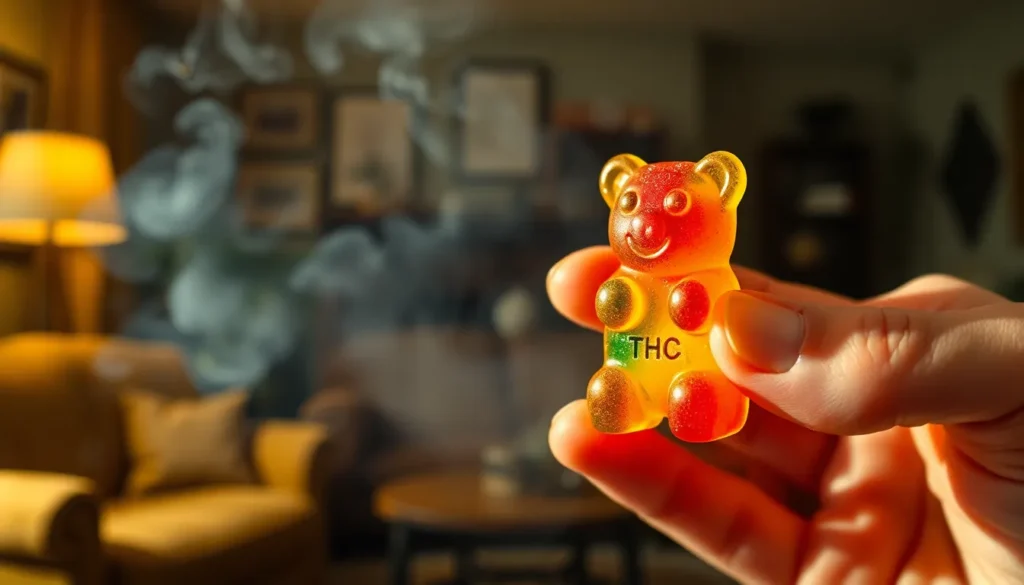When it comes to enjoying THC, the age-old debate between popping a gummy and lighting up a joint is as heated as a summer barbecue. Many wonder if 5 mg of THC can pack the same punch as a few puffs from a classic joint. Spoiler alert: they’re not quite the same, but both have their perks and quirks.
Picture this: one option offers a mellow ride with a predictable outcome, while the other could take you on a wild rollercoaster of highs and lows. Whether you’re a seasoned connoisseur or a curious newbie, understanding the differences can help make the right choice for your next chill session. So, let’s dive into the delightful world of THC and explore how 5 mg stacks up against the smoky clouds of tradition.
Table of Contents
ToggleOverview of THC Consumption Methods
THC consumption methods vary significantly in onset, duration, and overall effects. Smoking provides an almost immediate effect as the THC quickly enters the bloodstream through the lungs. Users often report feeling the psychoactive effects within minutes, quickly achieving the desired state.
Edibles, on the other hand, such as gummies, require digestion before THC enters circulation. This process can take from 30 minutes to 2 hours. Consequently, consumers might underestimate the timing and intensity of the effects, especially with a dose like 5 mg.
While many enjoy the convenience and discretion of edibles, the experience may differ markedly from smoking. Smokers often report a more controllable and immediate experience, whereas edibles typically provide a gradual buildup in effects.
Another consideration is the duration of effects. Smoking yields effects that last approximately 1 to 3 hours. In contrast, users of edibles may feel the impact for 4 to 8 hours or more. Longer-lasting effects can lead to more intense experiences for some individuals.
Variability in metabolism also influences how THC is processed. Factors like body weight, diet, and metabolism can alter the effects and intensity experienced with both methods.
Understanding these differences empowers users to choose based on their preferences and goals. Selecting between 5 mg of THC in an edible or smoking a joint involves considering factors like onset time, duration of effects, and the desired level of control over the experience.
5 Mg of THC Explained
5 mg of THC from edibles, like gummies, presents a distinct experience compared to smoking. This dosage serves as a precise entry point for users exploring THC effects.
Effects of 5 Mg Dosing
Effects often vary significantly based on consumption method. Users consuming 5 mg of THC through edibles typically experience a slower onset, which can range from 30 minutes to 2 hours. Once it takes effect, the experience may last 4 to 8 hours. Smokers, in contrast, feel nearly immediate effects that last 1 to 3 hours. The intensity of effects can also differ, as edibles may lead to a more profound and prolonged experience. Individual factors, such as metabolism and body weight, influence these outcomes. As a result, the same 5 mg of THC might produce diverse reactions among users.
Benefits of Dosing Precision
Dosing precision offers several advantages for responsible consumption. Knowing exactly how much THC is consumed allows users to tailor their experiences. This specificity helps in avoiding overconsumption, a common challenge with less measurable methods like smoking. Furthermore, it encourages new users to start with lower doses, enhancing comfort and control. Accurate dosing can also facilitate consistency in experiences. Users seeking therapeutic benefits find it particularly beneficial, enabling them to manage symptoms effectively while minimizing adverse effects.
Comparing Ingesting vs. Smoking
THC consumption methods significantly impact user experiences. Edibles deliver effects through digestion, while smoking allows instantaneous absorption.
Onset Time and Duration of Effects
Users feel the effects of smoking almost immediately, typically within minutes. In contrast, edibles take longer to kick in, often requiring 30 minutes to 2 hours for onset. Effects from smoking last between 1 to 3 hours, providing a shorter experience. Conversely, the duration of edibles can extend from 4 to 8 hours or even longer. This longer-lasting effect may lead to a more intense experience for some individuals. Variability in metabolism, weight, and individual tolerance further influences how long these effects persist.
Differences in Bioavailability
Bioavailability varies between smoking and edibles. Smoking offers about 30 to 50 percent bioavailability due to direct absorption in the lungs. Conversely, edibles undergo digestion, leading to a lower bioavailability of approximately 10 to 20 percent. Though lower, this bioavailability from edibles results in more potent effects due to metabolism in the liver, converting THC to 11-hydroxy-THC. This compound enhances the psychoactive experience, making edibles potentially feel stronger despite the lower bioavailability. Understanding these differences helps users navigate their options effectively.
Health Considerations
Health considerations for THC consumption vary between methods, particularly between edibles and smoking. Understanding these differences is critical for informed decision-making.
Respiratory Health Impacts
Smoking THC can lead to respiratory issues due to inhaling combusted materials. Regular use often increases the risk of lung-related conditions. In contrast, consuming THC through edibles avoids these respiratory concerns entirely. They don’t involve inhalation, thus promoting better lung health. Long-term smokers may experience chronic cough or irritation, while edible consumers bypass these risks. Assessing personal health is important when choosing a consumption method.
Long-Term Effects of Each Method
Long-term effects of smoking THC include potential dependency and varied cognitive impacts. Regular users might experience changes in memory or learning capability. Edibles present a different scenario; though they can provide a delayed onset of effects, their impact on cognitive function can also be significant. Patients seeking therapeutic benefits often opt for edibles due to their longer-lasting effects. Both methods pose unique risks, so individual experience matters when weighing options. Understanding metabolism also plays a role in how long users feel the effects, particularly with edibles.
Personal Preferences and User Experience
User experiences significantly vary between consuming 5 mg of THC through edibles and smoking it. Preferences often stem from desired effects and individual tolerances. Some individuals seek the rapid onset of smoking, enjoying immediate psychoactive effects. They appreciate feeling high within minutes, which suits those who prefer quick relief or social settings.
In contrast, others opt for edibles due to their longer-lasting effects. Many find that a 5 mg gummy provides a slow, steady experience that can last from 4 to 8 hours. Longer durations appeal to users looking for sustained symptom relief.
User metabolism plays a critical role in determining how THC affects them. Individuals with faster metabolisms may process 5 mg of THC from edibles differently than those with slower rates. The conversion of THC to 11-hydroxy-THC can intensify the high for some, leading to varied experiences even at the same dosage.
Concerns about respiratory health might influence choices as well. Smokers sometimes avoid inhaling combusted materials, opting for edibles to lessen harm to their lungs. Those prioritizing health may lean towards edibles, recognizing the potential risks of smoking.
User feedback indicates that while 5 mg serves as a good starting point, personal preferences matter. A user’s previous experiences with THC consumption can shape their choice of method. Individuals new to THC may prefer starting with edibles to control their experience more precisely, while seasoned users might prefer the immediacy of smoking. Balancing these preferences allows for a more tailored approach to THC consumption.
Choosing between 5 mg of THC in edibles and smoking involves understanding personal preferences and desired effects. The rapid onset of smoking appeals to those seeking immediate relief while the prolonged effects of edibles cater to users looking for longer-lasting experiences.
Health considerations play a crucial role in this decision-making process. Those concerned about respiratory health may lean towards edibles to avoid potential lung issues. Ultimately, knowing how each method affects the body allows users to make informed choices tailored to their unique needs and lifestyles. Whether it’s the quick buzz from smoking or the enduring high from edibles, understanding these differences enhances the overall THC experience.









